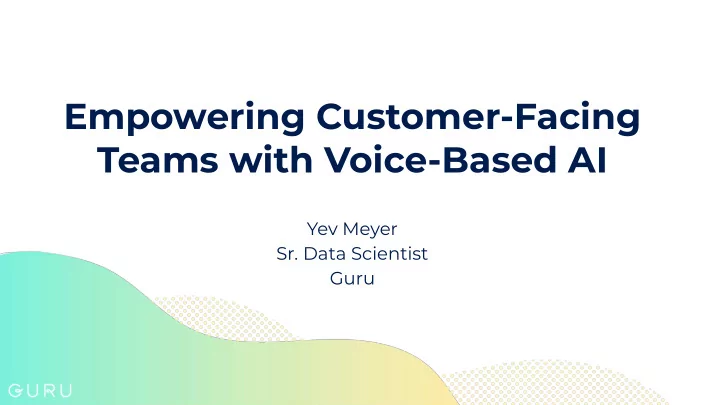

Empowering Customer-Facing Teams with Voice-Based AI Yev Meyer Sr. Data Scientist Guru
Guru’s mission
We believe the knowledge you need to do your job should find you
Information workers switch windows on average 373 times per day or around every 40 seconds while completing their tasks. (Mark et al., 2016) (Molla, 2019)
ML supporting the mission Guru gathers your company's knowledge — from experts, documents, applications — and unifies it into a single source of truth . Using ML, Guru then surfaces that knowledge to you in your favorite work applications (Slack, Intercom, Zendesk, Salesforce, Gmail, etc.)
A few ML features in production AI Suggest Voice suggest knowledge in real-time in phone conversations and conference calls AI Suggest Text suggest knowledge in real-time in chat tools, ticketing systems, or email clients AI Suggest Experts Listen Transcribe Recommend to Audio Speech to Text Knowledge suggest subject matter experts to answer questions and verify knowledge AI Suggest Tags suggest knowledge tags to help organize knowledge Duplicate Detection identify duplicate knowledge to ensure there is only a single source of truth
AI Suggest Voice
Demo
A hard problem to solve end-to-end Client-side capture audio for both parties (simplest case) ● ● stream all data in real-time support a variety of OS and hardware ● ● create UX that does not distract DS-side transcribe speech and suggest knowledge, all in real-time ● ● handle speech detection, speaker separation, noise take custom jargon into account ● ● have scalable infrastructure for streaming, model training and serving embrace customer diversity: serve multiple models supporting the above ● ● make it cost-effective: GCP/AWS/Azure transcription is prohibitively expensive added benefit: specialized model , built for a specific use-case ○ ● get data for training the acoustic model
High-level architecture
Speech2Text service
Standing on the shoulders of giants. Literally. ● Neural nets have been used in speech recognition for over 20 years ● However, there was no true end-to-end deep learning solution until ~2014 ● Traditional systems employed heavily engineered processing stages, HMMs ● Baidu’s was one of the first end-to-end demonstrations, predicting sequences of characters from input audio ⇒ Baidu’s highly-simplified speech recognition pipeline has democratized speech research ⇒ Mozilla is one of the companies that was inspired to contribute to speech research
The approach: high-level ● Goal: given an utterance , , generate a transcription sequence , ● Approach: train a network that would allow us to extract from the final layer ● Use RNN, with a sequence of log-spectrograms as features, where p denotes the frequency band. First three layers: non-recurrent, fully connected, taking neighboring context C into account Fourth layer: uni-directional recurrent Fifth layer: standard softmax
The approach: training ● The main challenge is that the transcription length stays the same across audio lengths ● We use connectionist temporal classification, or CTC (Graves et al., 2006) ● Layer 5 encodes a probability distribution over character sequences , where ● Define a many-to-one map ● Can now compute ● Update parameters:
The approach: inference ● Decode the output, i.e., find the most likely transcription, e.g., by using max decoding via or using prefix-decoding ● However, even with best decoding, you see spelling and linguistic errors (the “Tchaikovsky” problem) Introduce a language model (LM) ○ We use an n-gram model (KenLM) that is ○ trained on publicly available corpora Can quickly look up words via beam search ○ Most importantly, can quickly update with ○ new or newly-important words
Text2Knowledge service
Text2Knowledge ● Offline: run an NLP pipeline to extract features from individual pieces of knowledge (cards) and embed each card in a multi-dimensional space ● Use these features along with user-interaction data to train a weakly-supervised recommender system ● Weakly supervised, since not all interactions guarantee that a card was used in a conversation. In other words, the labels are noisy. ● Online: process newly-observed text using the same NLP pipeline and suggest top K cards.
Quick Recap
Quick Recap Our mission: the knowledge you need to do your job should find you ● AI Suggest Voice: applying the above to voice ● This is a hard problem to solve end-to-end ● Doable, given recent advances in e2e deep learning for speech ● recognition RNN + CTC + LM works really well ● Speech2Text + Text2Knowledge = Speech2Knowledge ●
Lessons learned
Lessons learned: quality data is key ● The biggest challenge is having access to audio data for training ● Baidu’s network was trained on more than 10k hours of audio ● Mozilla realized that access to such data will allow for broad innovation in the space. Hence, Common Voice ● Can use other public data sets ● Can also synthesize data ● LM: quality data matters
Other lessons learned ● Audio packets coming from the client out of order ● Transcriptions being generated out of order ● Serverless VAD is a real challenge ● N-gram LMs are quite large ● Scalability lessons galore ● Being gritty We are a small team, but we have grit ○
The most important slide
Everything discussed is a fruit of many people’s labor at Guru. Jenna Bellassai Ed Brennan Bernie Gray Yev Meyer Nabin Mulepati Product Data Science Team Come say hi and stop by our booth!
Thank you!
References Mark G., Iqbal S., Czerwinski M., Johns P., Sano A. Neurotics Can't Focus: An in situ Study of Online Multitasking in the Workplace. Proceedings of the 2016 CHI Conference on Human Factors in Computing Systems, 2016. Molla R. The productivity pit: how Slack is ruining work. Recode, 2019 https://www.vox.com/recode/2019/5/1/18511575/productivity-slack-google-microsoft-facebook. Accessed 12 Nov. 2019. Hannun A., Case C., Casper J., Catanzaro B., Diamos G., Elsen E., Prenger R., Satheesh S., Sengupta S., Coates A., Ng A. Deep Speech: Scaling up end-to-end speech recognition. arXiv:1412.5567v2 [cs.CL], 2014. Graves A., Fernández S., Gomez F., Schmidhuber J. Connectionist temporal classification: labelling unsegmented sequence data with recurrent neural networks, ICML '06 Proceedings of the 23rd international conference on Machine learning
Recommend
More recommend